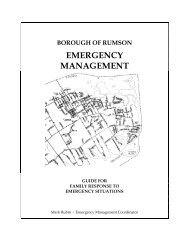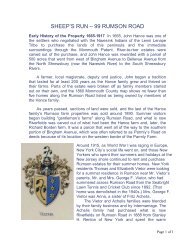Two River Regional Police Study Group Introduction Purpose
Two River Regional Police Study Group Introduction Purpose
Two River Regional Police Study Group Introduction Purpose
Create successful ePaper yourself
Turn your PDF publications into a flip-book with our unique Google optimized e-Paper software.
<strong>Two</strong> <strong>River</strong> <strong>Regional</strong><br />
<strong>Police</strong> <strong>Study</strong> <strong>Group</strong><br />
.<br />
Presentation to<br />
Joint Meeting of Participants<br />
Presented by:<br />
PATRIOT<br />
CONSULTING GROUP<br />
9 July 2008<br />
Little Silver Municipal Building<br />
PATRIOT<br />
CONSULTING GROUP<br />
• Brian J. Valentino<br />
– President<br />
– Principal Consultant<br />
• Dennis E. Godek<br />
– Vice President, Public Safety Services Div.<br />
– Director, Cradle of Liberty <strong>Regional</strong> Ops.<br />
• 732-413<br />
413-0515<br />
© 2008 - Patriot Consulting <strong>Group</strong>, Inc.<br />
<strong>Introduction</strong><br />
• RFP <br />
• $25,000 NJ SHARE Grant <br />
• Mobilization <br />
• Investigation <br />
• Analysis <br />
• Report <br />
<strong>Purpose</strong><br />
• First of several meetings<br />
• Brief elected officials<br />
• Discuss sharing feasibility<br />
• Offer initial recommendations<br />
• Review potential courses of action<br />
• Anticipation of completing final report
Department Data<br />
• 46 Sworn <strong>Police</strong> Officers<br />
• 19,244 year round residents 9.6 miles<br />
in land area<br />
• $6.85 Million dollars per year for police<br />
& dispatch services in personnel<br />
related costs (2007).<br />
• “Calls for Service” data inconsistent<br />
Results<br />
• Similarities between the three towns:<br />
– Community Demographics<br />
– Community Identity<br />
– <strong>Police</strong> Identity<br />
– Municipal Philosophy<br />
– <strong>Police</strong> Philosophy<br />
– Community Culture<br />
– <strong>Police</strong> Culture<br />
– Types of Calls for Service<br />
Results<br />
• Reviewed<br />
– Rules & Regulations<br />
– Ordinances & Statutes<br />
– Budgets<br />
– Total Personnel Costs<br />
– Call Volume & Demands for Services<br />
• Interim Meetings<br />
– <strong>Study</strong> <strong>Group</strong><br />
– Chiefs of <strong>Police</strong><br />
Decision Rules<br />
• All recommendations MUST<br />
– Maintain or preferably improve law<br />
enforcement service delivery to the public.<br />
– Result in a projected cost savings<br />
– OR must be rejected.
Input, Guidance & Notice<br />
• Executive & Legislative<br />
– Elected Officials<br />
• Management<br />
– Chiefs of <strong>Police</strong><br />
• Rank & File<br />
– Civilian Employees<br />
– Sworn Officers<br />
– Unions and Union Representatives<br />
• Regulators and Rule Makers<br />
– Monmouth County Prosecutor’s s Office<br />
– State of New Jersey<br />
• Department of Community Affairs (Local Gov’t t Services)<br />
• Department of Law & Public Safety<br />
General Observations<br />
• The three municipalities are receiving<br />
outstanding yet duplicate police<br />
services.<br />
• Many of the services studied are<br />
already being shared in some informal<br />
manner.<br />
• Common sense dictates that these<br />
three similar towns can share some,<br />
and possibly all, of their police services.<br />
Shared Services<br />
Make Sense Now<br />
• Purchasing<br />
• Communications & IT<br />
• Prisoner Processing/Holding<br />
• Criminal Investigations (Detectives)<br />
• Traffic<br />
• Youth Aid<br />
During Sharing<br />
• Shared function officers work at one agency as a<br />
team.<br />
• Cross jurisdictional assignments<br />
• Individual Chiefs continue to command their own<br />
officers<br />
• Patrol functions remain in existing departments.<br />
• NO recommended layoffs, terminations or<br />
reductions in staffing of sworn law enforcement<br />
officers due to sharing of services.<br />
• No recommendations that will result in a reduction<br />
of services
TOWN A<br />
Known Issues<br />
TOWN B<br />
TRAFFIC<br />
I.T. SERVER<br />
YOUTH AID<br />
CROSSING GUARDS<br />
COMMUNICATIONS<br />
PRISONERS<br />
DETECTIVES<br />
TOWN C<br />
• Call Data<br />
• Financial Data<br />
• “Unpredictables”<br />
• Opinion of the Chiefs of <strong>Police</strong><br />
– Have already informed the <strong>Study</strong> <strong>Group</strong><br />
that they cannot support all of the<br />
recommendations.<br />
– They prefer the immediate versus<br />
incremental regionalization of all three<br />
departments.<br />
Recommendation 1<br />
• Traditional shared services<br />
agreements should be executed to<br />
implement the sharing of<br />
communications, information<br />
technology, detectives, youth aid,<br />
prisoner observation, purchasing and<br />
traffic functions between and among<br />
the three towns.<br />
Recommendation 2<br />
• Prepare for and then establish a Joint<br />
Management Committee or other<br />
structure to oversee sharing and<br />
regionalization efforts.
Recommendation 3<br />
• As soon as technologically feasible,<br />
implement uniform collection of call<br />
data tracking how law enforcement<br />
officers are deployed, how efficiently<br />
they operate while deployed and<br />
what functions they are required to<br />
perform during deployment.<br />
Recommendation 4<br />
• As soon as a significant set of call<br />
data is collected, the feasibility of a<br />
full regionalization of all law<br />
enforcement services should be<br />
considered.<br />
During Sharing<br />
• Shared function officers work at one agency as a<br />
team.<br />
• Cross jurisdictional assignments<br />
• Individual Chiefs continue to command their own<br />
officers<br />
• Patrol functions remain in existing departments.<br />
• NO recommended layoffs, terminations or<br />
reductions in staffing of sworn law enforcement<br />
officers due to sharing of services.<br />
• No recommendations that will result in a reduction<br />
of services<br />
Known Issue<br />
• The Chiefs of <strong>Police</strong>, as a group, do not<br />
support the sharing of Detectives,<br />
Traffic or Youth Aid functions.<br />
– Purchasing<br />
– Communications & IT<br />
– Prisoner Processing/Holding<br />
– Criminal Investigations (Detectives)<br />
– Traffic<br />
– Youth Aid
Consultant’s s Position<br />
• The recommendations meet the<br />
directions of the <strong>Study</strong> <strong>Group</strong><br />
– Maintain or Improve Services<br />
– Reduce Costs<br />
• Many of the areas recommended for<br />
sharing are<br />
– Already being shared informally<br />
– Common sense<br />
– Reduce waste, inefficiency and<br />
redundancy<br />
Consultant’s s Position<br />
• The recommendations enhance the<br />
quality of life for the average law<br />
enforcement officer and dispatcher<br />
– More variety<br />
– Larger response area<br />
– Specialized teams<br />
– More diversity<br />
– More promotional opportunities<br />
– Expanded training opportunities<br />
Purchasing<br />
Communications<br />
• Centralized Purchasing Operation (with<br />
existing staff)<br />
• Bulk Purchasing<br />
• Scales of Economy<br />
• Standardization<br />
• Simplification<br />
• Safety and Cohesion<br />
• Reduced Overall Costs<br />
• Centralized<br />
Emergency<br />
Communications<br />
Center<br />
• 2 dispatchers, 24/7<br />
• Higher training<br />
standards<br />
• Possible designation<br />
as an E-9-1-1 E 1 PSAP.<br />
• New and upgraded<br />
radio and<br />
communications<br />
equipment paid for<br />
by State<br />
Implementation<br />
Grant<br />
• Use of GPS/AVL<br />
technology
Communications<br />
• Increased, Improved and Enhanced<br />
Communication<br />
– All three agencies on ONE dispatch<br />
channel<br />
– Multiple tactical channels if necessary<br />
– Closest unit can be dispatched/provide<br />
backup<br />
– Improved response time<br />
Known Issue<br />
• At least one Chief has stated that he<br />
also will not support the sharing of<br />
communications functions unless they<br />
are housed in his municipality.<br />
– Purchasing<br />
– Communications & IT<br />
– Prisoner Processing/Holding<br />
– Criminal Investigations (Detectives)<br />
– Traffic<br />
– Youth Aid<br />
Information Technology<br />
Prisoner Observation<br />
• Standardized &<br />
Computer Aided<br />
Dispatch and Records<br />
Management System<br />
• Already in use in<br />
Rumson<br />
– Requested by both Little<br />
Silver and Fair Haven<br />
PDs<br />
• Officers can do more in<br />
the field<br />
• Allows for the uniform<br />
collection of call data<br />
• Tracking how law<br />
enforcement officers<br />
are deployed<br />
• How efficiently they<br />
operate while deployed<br />
• What functions they<br />
are forced to perform<br />
during deployment<br />
• Centralized Processing & Detention<br />
Center<br />
• Formalizes current sharing of prisoner<br />
processing technology.<br />
• More efficient use of personnel.<br />
• Increases officer, dispatcher &<br />
prisoner safety.<br />
• More efficient use of facilities funding.
Criminal Investigations<br />
Youth Aid Team<br />
• Centralized detective<br />
bureau<br />
– One supervising detective<br />
– <strong>Two</strong> detectives<br />
• Formalizes current sharing<br />
of detective resources and<br />
personnel.<br />
• More efficient use of<br />
personnel.<br />
• Detectives “on-duty” more<br />
often.<br />
• Cross-jurisdictional<br />
assignments<br />
• More efficient use of Patrol<br />
Officers<br />
• Allows for additional<br />
expertise to crime scenes<br />
and investigations<br />
• Increases communication<br />
between all three<br />
departments<br />
• Anticipated increase in the<br />
number of solved cases.<br />
• Expressed desire of many<br />
Elected Officials<br />
• Formalizes Current Sharing<br />
• Specific responsibilities:<br />
– Crimes on school property<br />
– All Cases with Juvenile<br />
Victims or Defendants<br />
– D.A.R.E./Drug Education<br />
– Juvenile Public Relations<br />
– Youth Community <strong>Group</strong>s<br />
– School “Presence”<br />
– DYFS Referrals<br />
– Complaints involving<br />
Juveniles<br />
• Provides Flexibility<br />
– Traditional Youth Outreach<br />
– Non-Traditional & “High<br />
Risk”<br />
• IACP also recommends,<br />
citing:<br />
– Communications<br />
– Partnerships<br />
– Law Enforcement<br />
– Families & Youth<br />
– Mental Health Services<br />
– Advocacy<br />
• School Resource Officer(s)<br />
Traffic Bureau<br />
• One Traffic Safety Supervisor<br />
• Three Traffic Safety Officers<br />
• Formalizes Current Sharing<br />
• Organization<br />
– Traffic Safety & Accident Investigations<br />
– Traffic Enforcement<br />
– School Crossing Guards (Potentially)<br />
Traffic Bureau<br />
• Traffic Safety & Accident<br />
Investigations Team<br />
– Traffic Safety Operations<br />
• Signs<br />
• Lights<br />
• Signals<br />
• Lines<br />
• General Traffic Safety Initiatives
Traffic Bureau<br />
• Traffic Safety & Accident<br />
Investigations Team<br />
– Accident Investigation Team<br />
• Specialized Training<br />
• Conducts Investigation & Follow up<br />
• Allows Patrol Officers to return to PATROL<br />
functions more quickly<br />
• Work closely with Monmouth County Serious<br />
Collision Analysis Response Team (SCART)<br />
Traffic Bureau<br />
• Traffic Enforcement Team<br />
– Targeted, Routine & Special Enforcement<br />
– Goal is Rapid Response to Citizen Complaints<br />
• Speeding<br />
• General Traffic Complaints<br />
– Allows Patrol Officers to remain on PATROL &<br />
available for Emergencies.<br />
– Permissive use of Patrol Officers performing<br />
Traffic Enforcement duties.<br />
Traffic Bureau<br />
• School Crossing Guards<br />
– Local Option<br />
– Allows for pooling of resources and<br />
personnel<br />
– Helps avoid use of law enforcement for<br />
crossing guard functions<br />
– Standardization<br />
Full <strong>Regional</strong>ization<br />
• Full <strong>Regional</strong>ization may be feasible<br />
when the Sharing Plan has been in<br />
operation long enough to:<br />
– Assess its effectiveness on a limited scale<br />
– Assess its viability<br />
– Collect sufficient call data to determine<br />
• Call Type, Number and Statistics<br />
• Committed vs. Uncommitted Officer Time<br />
• Deployment Characteristics
Sharing Plan<br />
• Share & Assess<br />
– Communications & IT<br />
– Prisoners<br />
– Detectives<br />
– Traffic<br />
– Youth Aid<br />
– Purchasing<br />
• Existing three police departments remain in<br />
full force and effect<br />
Next Steps<br />
• Discussion & Debate<br />
– Municipality specific<br />
– As a group<br />
• Plan for and implement Joint Management<br />
Committee to oversee sharing operations<br />
and long term activities<br />
• Adopt traditional Interlocal/Shared Services<br />
agreements to implement sharing<br />
• Apply for NJ SHARE Implementation grants<br />
<strong>Two</strong> <strong>River</strong> <strong>Regional</strong><br />
<strong>Police</strong> <strong>Study</strong> <strong>Group</strong><br />
.<br />
Presentation to<br />
Joint Meeting of Participants<br />
Presented by:<br />
PATRIOT<br />
CONSULTING GROUP<br />
9 July 2008<br />
Little Silver Municipal Building<br />
© 2008 - Patriot Consulting <strong>Group</strong>, Inc.




![Job Description Administrative Assistant 2012[1] - Rumson Borough](https://img.yumpu.com/36562647/1/190x245/job-description-administrative-assistant-20121-rumson-borough.jpg?quality=85)






